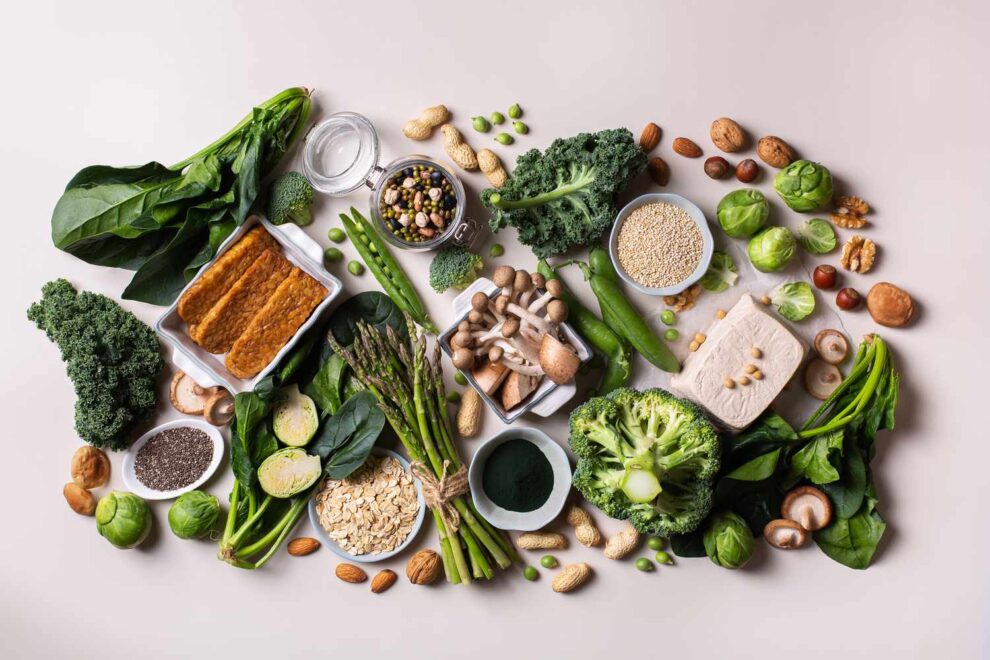Protein is needed to build and maintain healthy muscles, bones, and skin. Although we most commonly associate high-protein foods with animal products, several vegetables are also good protein sources.
Incorporating plant-based protein into your diet can help you meet your protein needs while fueling your body with vitamins, minerals, fiber, and beneficial plant compounds it needs to stay healthy.
Here are 12 high-protein vegetables to incorporate into your diet.
Lentils
Lentils, peas, and beans are considered to be a vegetable and protein, offering the best of both worlds. They provide nutrients similar to meats, poultry, and fish while offering fiber, folate, potassium, and other essential nutrients found in vegetables.1
One cup of cooked lentils provides 18 grams (g) of protein and 15.6 g—about 56% of the Daily Value (DV)—for fiber.2
Lentils are high in lysine but low in methionine, while whole grains like rice are high in methionine but low in lysine. Combine the two to provide all nine essential amino acids needed by the body.2
You can also use lentils in soups, stews, casseroles, and salads.
Split Peas
Split peas contain 16 g of protein per cooked cup, nearly triple the amount of protein provided by two boiled eggs. Each cup also contains 57% of the DV for fiber and decent amounts of folate, iron, and potassium.3
Fiber is very important for our health. Increasing your daily fiber intake can help:4
- Maintain regular bowel movements
- Prolonged satiety and hunger levels
- Reduce cholesterol levels
- Keep blood sugar levels in a healthy range
- Promote healthy gut bacteria
Split peas are often cooked into soups and casseroles. However, they can also be cooked alone and incorporated into salads or grain bowls for a protein boost.
Spinach
Spinach is one of the most nutrient-rich vegetables on the planet. One cup of cooked spinach contains 6 g of protein, with just 49 calories.5
Spinach is also packed with disease-fighting antioxidants, vitamins, and minerals. Each cooked cup provides the following nutrients:5
- Fiber: 17% of the DV
- Calcium: 16% of the DV
- Iron: 32% of the DV
- Magnesium: 40% of the DV
- Potassium: 25% of the DV
- Zinc: 10% of the DV
- Vitamin C: 46% of the DV
- Folate: 77% of the DV
- Vitamin K: 850% of the DV
Spinach is exceptionally high in vitamin K, which is important for bone health and blood clotting.6
Sauté spinach, garlic, and olive oil for a nutritious side dish. You can also top raw spinach leaves with strawberries, blueberries, beans, and nuts for a filling, protein-packed meal.
Edamame
Edamame is often overlooked yet incredibly beneficial for our health. One cup of prepared edamame boasts 18 g of protein along with 29% of the DV for fiber and over 100% of the DV for folate.7
Folate is a B vitamin that helps the body make healthy, new red blood cells. It is especially important before and during pregnancy, as it helps protect unborn babies against severe birth defects called neural tube defects.8
Edamame is also a good source of several other nutrients, including phosphorus, iron, potassium, and zinc.
Edamame can be enjoyed alone as a high-protein snack or incorporated into stir-fries, noodle bowls, and salads.
Chickpeas
Chickpeas are an affordable, nutrient-dense legume. One cup of cooked chickpeas provides 14.5 g of protein, with 45% of the DV for fiber. They’re also high in vitamins, minerals, and polyphenols, which have potent antioxidant activity.9
Polyphenols in the diet have been shown to improve blood pressure, cholesterol levels, insulin resistance, and chronic inflammation.10
One study found that consumers of hummus or its main component, chickpeas, have higher dietary intakes of fiber, healthy fats, vitamins A, C, and E, folate, magnesium, potassium, and iron than people who don’t consume hummus.11
Research suggests chickpeas and hummus may also support weight management, blood sugar regulation, and heart health.11
You can mash chickpeas to create a creamy hummus, toss them with olive oil and salt, or roast them in the oven.
Black Beans
Black beans are a staple in many kitchens—for a good reason. One cup of cooked black beans contains 15.2 g of protein and 15 g of fiber. Black beans also supply nutrients like iron, magnesium, phosphorus, and potassium.12
Plus, compared to other beans, black beans are richer in anthocyanins, or plant pigments that have antioxidant and anti-inflammatory effects in the body. The anthocyanins in black beans have also been linked to improved heart health and blood sugar control.13
Black beans are highly versatile and can be enjoyed in tacos, chili, casseroles, and salads.
Fava Beans
Fava beans, or broad beans, are green legumes enclosed in a thick, fuzzy pod. They’re packed with protein, fiber, vitamins, and minerals.
One cup of cooked fava beans provides 13 g of protein and 9 g of fiber with just 187 calories. It also contains 44% of the DV for folate and 17% of the DV for magnesium, a nutrient that plays a role in brain function and mood.14
Fava beans can be eaten raw or cooked. They’re often enjoyed in soups, salads, or as a standalone side dish.
Lima Beans
Lima beans, also known as butter beans, are vegetables from the legume family. One cup of cooked lima beans contains 14.7 g of protein, with 13.2 g of fiber.15
Lima beans are exceptionally high in copper and manganese, providing 49% and 42% of the DV, respectively.
Copper is vital for immune health and healthy brain function.16 Manganese is used by the body to make energy and protect cells from damage.17
Lima beans can be purchased canned, frozen, or dried. They have a creamy texture and slightly sweet flavor, making them a great addition to soups and salads.
Broccoli
Broccoli is higher in protein than many other vegetables, providing 4 g of protein in a medium cooked stalk. Each stalk also contains 130% of the DV for vitamin C, a natural antioxidant that can increase the amount of iron absorbed from plant sources.18
Vitamin C is also important for a healthy immune system and the production of collagen, a protein vital for wound healing and skin health.19
Broccoli and other cruciferous vegetables contain glucosinolates, a phenolic compound with anti-inflammatory, antioxidant properties that may aid in treating and preventing several chronic diseases.20
Broccoli is extremely versatile and can be enjoyed steamed, roasted, or added to casseroles for a nutrient boost.
Asparagus
While it has the potential to make your pee smell a little strange, asparagus is packed with nutrients. In addition to being low in calories and fat, one cup of asparagus provides 4.3 g of protein and 3.6 g of fiber. It’s also a good source of vitamins C and K.21
U.S. Department of Agriculture. Asparagus, cooked, boiled, drained.
Enjoy asparagus sautéed, roasted, or steamed. Avoid boiling asparagus, as it can make it flavorless and soggy.
Artichoke Hearts
Artichoke hearts are an underrated yet highly nutritious vegetable. They’re chock-full of antioxidants, fiber, vitamins, and minerals.
One cup of canned artichoke hearts provides 10 g of protein and nearly 20 g of fiber, with just 90 calories.22
You can roast raw artichokes or purchase artichoke hearts frozen, jarred, and canned. Artichoke hearts can also be enjoyed as a side dish or added to pasta and salads.
Sweet Corn
Although corn often gets a bad rap, it’s a nutritious vegetable that can be part of a healthy diet. One cup of cooked sweet corn contains 5 g of protein. It’s also a good source of fiber, containing 3.6 g per cup.23
Sweet corn can be boiled, roasted, steamed, or grilled. You can also add it to casseroles, salsa, and salads for additional fiber.
A Quick Review
Even though vegetables aren’t typically seen as significant sources of protein, many have a relatively high protein content. When they’re paired with a variety of foods, it can help you create a well-balanced diet and meet your daily protein needs.
Plus, vegetables are rich in vitamins, minerals, and other beneficial plant compounds that are good for weight management and are vital to good health.
Among the highest protein vegetables are chickpeas, corn, spinach, artichoke hearts, and edamame.
To get all of the amino acids your body needs, aim to eat a variety of foods, such as legumes, whole grains, nuts, seeds, and vegetables throughout the day.
Source : Health































